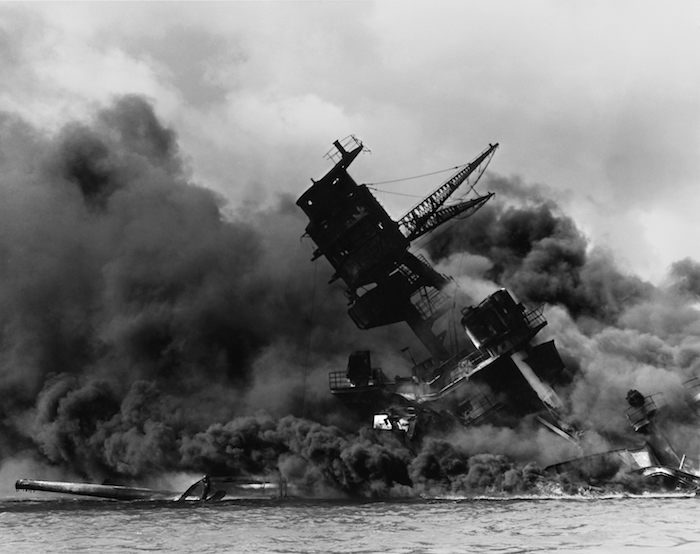|
By Jacob G. Hornberger On October 30, 1940, during his campaign for an unprecedented third term as president, Franklin Roosevelt told an audience in Boston, And while I am talking to you mothers and fathers, I give you one more assurance. I have said this before, but I shall say it again and again and again: Your boys are not going to be sent into any foreign wars. They are going into training to form a force so strong that, by its very existence, it will keep the threat of war far away from our shores. The purpose of our defense is defense. It was a lie. In actuality, FDR was secretly doing everything he could to embroil the United States into World War II to help Great Britain and France defeat Germany. Why secretly? Because he knew that the American people, having been fed a bill of goods by President Wilson some 20 years regarding World War I, were overwhelmingly opposed to entering another European war. If Roosevelt wanted to intervene in the war, why didn’t he just send U.S. troops into battle, just as later presidents would do in places like Korea, Vietnam, Iraq, Grenada, Afghanistan, Somalia, and others? This was during a time when presidents still complied with the constitutional provision that prohibits a president from waging war without first securing a declaration of war from Congress. FDR knew that if he went to Congress and asked for a declaration of war, as Wilson had for intervention into World War I, there was no chance that Congress would have consented to it. After the senseless loss of more than 100,000 U.S. soldiers in World War I — the war whose goal was to bring an end to all future wars and to make the world “safe for democracy” — the elected representatives of the American people were not about to assent to U.S. intervention into World War II. Therefore, FDR knew that he had but one chance to get the U.S. into the war. If he could only induce Germany into attacking the United States, he knew that Congress would have to declare war after such an attack. So, FDR did everything he could to induce Germany into attacking the United States, including having U.S. warships escort British ships in war zones and even going so far as to track and report on German submarines in the area. Also, under so-called “lend-lease” agreements, FDR began providing armaments to Great Britain. Although there were incidents regarding U.S. warships that were assisting Great Britain, Germany refused to take FDR’s bait by attacking the United States in a way that would have caused Congress to respond with a declaration of war. That’s because the Germans knew that it was U.S. intervention in World War I that had brought about Germany’s total defeat. The last thing they wanted was to go to war with the United States again. That caused FDR to shift gears and begin focusing on the Pacific — on Japan. Maybe, just maybe, he thought, he could maneuver Japan into attacking the United States and thereby provide a “back door” to the war in Europe that he wanted desperately to intervene in. That’s when he began squeezing Japan. He began demanding that Japan end its brutal military occupation of China. When Japan refused to comply with his order, FDR ordered a freeze on Japanese bank accounts in the United States. More important, he imposed complete embargo on U.S. oil shipments to Japan, an act that directly threatened the ability of the Japanese military to continue occupying China. When Japan entered negotiations with the United States in an attempt to avoid war with the U.S., FDR offered terms that he knew would be highly humiliating to the Japanese and that they would never accept. By this time, the United States had broken Japan’s diplomatic code and also possibly its military code (that part is still being held secret by the U.S. military) and so U.S. officials knew that war was imminent. Owing to FDR’s actions, Japan was faced with a bad choice. Either end its occupation of China owing to a lack of oil, or attack the U.S. Pacific fleet so that it could not interfere with Japan’s securing of oil supplies in the Dutch East Indies. Japan chose the latter course of action. Thus, contrary to what American schoolchildren are taught from the first grade on up, Japan never had any intention (or capability) of invading, conquering, and occupying the United States. The aim was simply to freely move into the Dutch East Indies, take their oil, and continue their occupation of China. That’s why U.S. troops were left in the Philippines and why U.S. ships were left at Pearl Harbor. FDR used them as bait for the Japanese to attack. Roosevelt was crafty enough to order U.S. carriers out of Hawaii so that they would still be available for war later on. But he just as craftily left destroyers and cruisers — and the men operating them at Pearl Harbor — so that the Japanese could be lured into attacking and providing FDR with his casus belli. It’s also why Gen. Douglas Macarthur and 10,000 American troops were left in the Philippines. They too were being used as bait. Of course, hardly anyone ever asks an important question: What in the world were U.S. troops doing in the Philippines? The answer is rooted in the Spanish American War in 1898, the “turning point” war in which the United States became an empire with colonies and America adopted a policy of foreign interventionism. The Philippines was one of its acquired colonies (and Puerto Rico and, effectively, Cuba). In fact, it was also around that time that the United States annexed Hawaii as a possession of the United States. As we all know, FDR got what he wanted, albeit at the cost of the lives of American soldiers who were used as FDR’s bait. To secure its oil supplies in the Dutch East Indies, Japan attacked the Philippines and Hawaii, thereby enabling FDR to secure his congressional declaration of war from Congress. Germany quickly obliged FDR with a declaration of war on the United States, thereby giving FDR his “back door” to the European conflict. This article was orignally published at The Future of Freedom Foundation.
Comments are closed.
|
Archives
July 2024
|



 RSS Feed
RSS Feed



